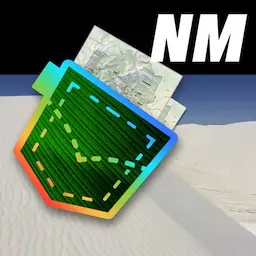"Sevilleta NWR" by Joel Deluxe , public domain
Tear SheetSevilleta |
Tear sheet for Sevilleta National Wildlife Refuge (NWR) in New Mexico. Published by the U.S. Fish & Wildlife Service (USFWS).
featured in
| New Mexico Pocket Maps |  |
U.S. Fish & Wildlife Service
Sevilleta National Wildlife Refuge
Welcome: Timeless Landscapes
Visitors are welcome at Sevilleta National Wildlife Refuge!
Experience the timeless beauty of Sevilleta NWR. Thunderstorms
roll across the enchanted mesas. A rainbow sweeps across the vast
blue sky to touch down on the banks of the Rio Grande. Bighorn
sheep balance on sandstone cliffs above San Lorenzo Canyon, while
the voices of hikers below echo through arches, caves, and windsculpted towers.
Here, in a refuge that spans 360 square miles, it’s easy to imagine
Piro Indians etching petroglyphs into rock hundreds of years ago.
The geologic story exposed in the rocks gives clues to a volcanic
past some 27 to 32 million years ago.
Converging Ecosystems
This refuge has a special purpose that sets it apart from other
national wildlife refuges across the country: To preserve and
enhance the integrity and natural character of the ecosystems of
the refuge.
Like intersecting highways, four major biomes unite at Sevilleta
NWR. Piñon–Juniper Woodlands intersect with the Colorado
Plateau Shrub–Steppe lands. The Chihuahuan Desert meets the
Great Plains Grasslands. In select places, all four converge.
For More Information Contact
Refuge Manager
Sevilleta National Wildlife Refuge
P.O. Box 1248
Socorro, New Mexico 87801
505/864-4021
505/864-7761 FAX
www.fws.gov/refuge/sevilleta/
January 2015
To add to the stunning diversity, the largest river in New Mexico,
the Rio Grande, bisects the immense landscape of Sevilleta NWR, a
lifeline for migrating birds and corridor for wildlife.
Research on the Refuge
Look for beaver tracks in the mud. Listen for ducks, geese, herons
and sandhill cranes, especially from November to February. In
summer, turtles bask on logs in water, roadrunners dart out from tall
grasses, and hawks soar overhead.
Sevilleta NWR hosts a diverse array of research projects
conducted by researchers from across the globe. The University of
New Mexico manages a Field Station and Laboratory on the refuge
to support these scientists in their field work.
Hunting
The Refuge offers dove and waterfowl hunting in the wetlands. Only
nontoxic shot is permitted. Please check with the refuge staff for
rules and regulations.
Things to Do at the Refuge
Visitor Center and Refuge Hours
Exhibits and Trails
Exhibits in the Visitor Center feature the cultural history,
biological diversity, geology, and latest news on scientific studies
and findings at the refuge.
Outside the visitor center, stretch your legs on the Mesa View,
Nature Loop, and Wildflower Loop trails, where you can observe
native plants and wildlife.
Biologists, geologists and other refuge experts lead guided tours
throughout the year. Education programs can be scheduled for
groups in advance.
San Lorenzo Canyon Geologic Journey
Millions of years of earth’s history unfold in San Lorenzo Canyon.
Whimsical sculpted sandstones and mudstones give clues to past
upheavals. A popular destination for hikers, the canyon offers
outstanding photography opportunities.
Life Giving Waters: Sevilleta Wetlands
Visit Sevilleta’s wetlands for a firsthand look at a success story for
wildlife. Seasonally flooding these lands near the Rio Grande recreates wetlands that were once extensive in the river valley.
Visitor Center and Refuge hours vary by season, please call or check
website prior to your visit.
Come prepared for unpredictable weather with hat, sunglasses,
water, and layers of clothing. Summer temperatures can soar to 100
degrees and then cool down considerably at night; you can expect
early afternoon monsoon rains from early July into September.
Winter temperatures can be cold and skies are frequently clear;
at night, the temperatures can often drop below freezing. You can
expect an occasional skiff of snow.
You can do your part to preserve Sevilleta NWR for wildlife and
people by obeying the following rules:
Drive only on designated roads.
Remain on refuge trails.
Do not disturb or remove wildlife, vegetation, rocks or historic objects.
Keep pets under control at all times
Photographs from left to right,
Ladrone Peak.
Gunnison’s Prairie Dog.
San Lorenzo Canyon.
Brown Bear.
Breadloaf at San Lorenzo Canyon
All Photographs / USFWS
U.S. Fish & Wildlife Service
Ladron
Peak
25
60
Rio
ns
tai
Mo
FE
Rio
SAN
TA
do
Pinos
s
AND
Cerro
Pelon
Lo
H
ATC
Sala
TOPEKA
r ones
q
La Joya
Cerro
Montoso
N
I SO
Lad
Rio
de
un
Puerco
Sier ra
G
n
ra
Waterfowl Management
Area
San Lorenzo
Canyon
Red Mt.
San
Acacia
Mesa
del Yeso
25
1400
Polvadera
Polvadera
Mt.
Sevilleta NWR Facts
Lemitar
251 Birds
Sevilleta
National Wildlife Refuge
N
Socorro
Peak
89 Mammals
58 Reptiles
15 Amphibians
0
2
4
6 Miles
8th largest NWR in
lower 48
Top, Los Pinos Mountains.
Middle, Roadrunner.
Bottom, Hedgehog cactus.
All photographs / USFWS
Socorro
Get the free m ob ile ap p at

